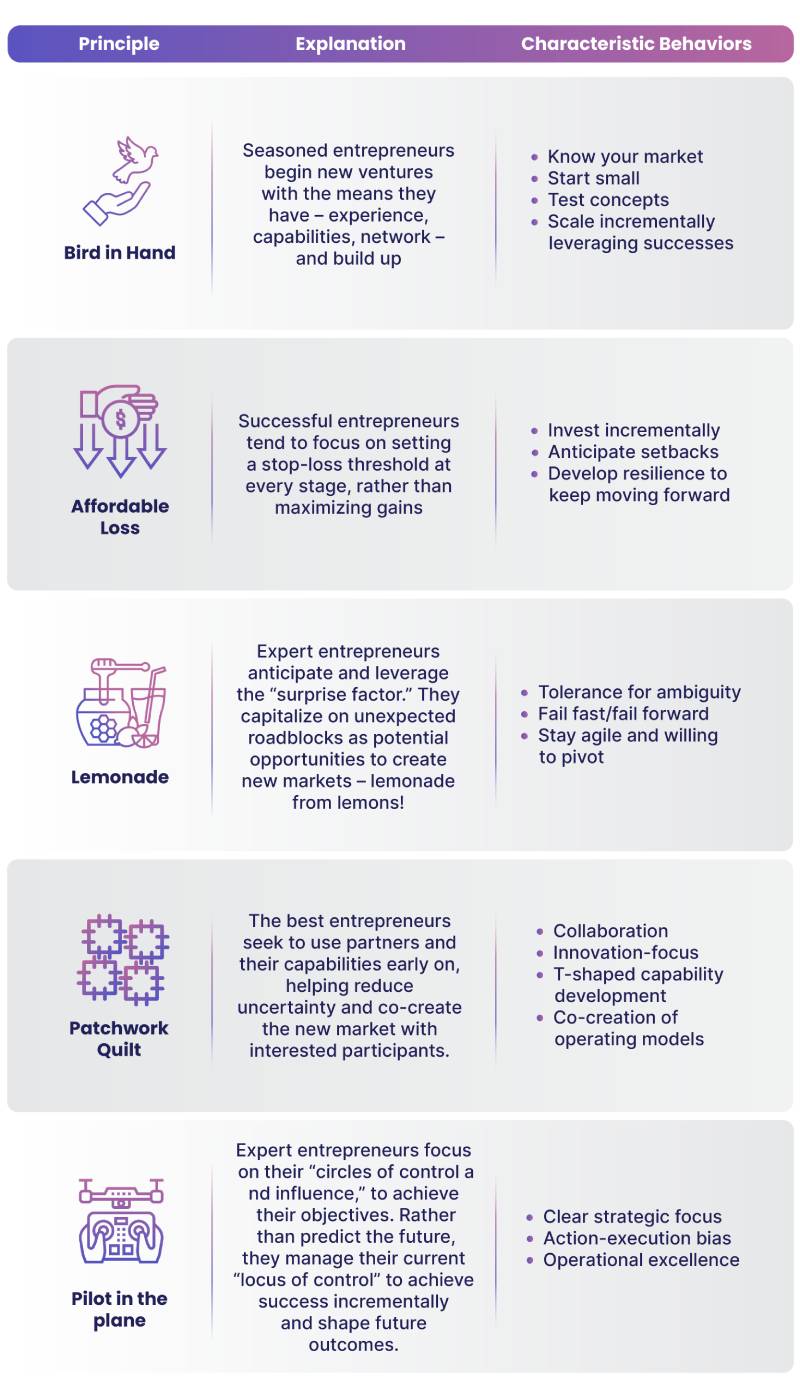It turns out that startups and talent acquisition (TA) leaders have an awful lot in common – particularly given the degree of uncertainty we are seeing in the market today.
So, how can TA tackle ongoing uncertainty and volatility? Well, if you listen to serial entrepreneurs, the future may be uncontrollable, but human actions can be influenced. And successful startups have historically viewed such moments as opportunities to shape a better future.
New startups in particular are steeped in uncertainty; founders often operate in volatile environments, facing chaos and contingencies more frequently than other businesses. The ability to adapt and manage this uncertainty can be the difference between success and failure.
The DNA of a successful startup
In her seminal work, the Effectuation model, Professor Sarasvathy at the Darden School of Business, provided a framework outlining key entrepreneurial characteristics leading to success:
Four lessons from startups
Many of the same principles outlined above can be applied to talent acquisition. Let’s take a look at what each looks like in context:
1. Mission: The best startups are mission-driven. Owing to smaller headcount and a relatively flat hierarchy, the mission – the problem they are solving for – is communicated clearly and frequently. Every person on the team is aware of the larger goal and understands how their role will help the organization get there.
In larger organizations however, the mission is often obscured due to rigid hierarchies and time constraints. This also occurs when business functions operate as individual parts (HR, admin, sales, marketing, etc.) rather than a cohesive whole.
For talent acquisition leaders, it is crucial that every member of the team understands and buys into the mission. TA teams cannot afford to function in a disjointed manner. TA leaders must ensure alignment between processes and teams, ensure visibility into how the function impacts business, and every member of the TA team should understand how their efforts feed into the mission. Think of it as a patchwork quilt, where different people, skills, and capabilities come together to create a mission-driven talent acquisition team.
2. Survival: Startups are built for speed, while larger, “traditional” companies are built to evade risks. To compete in a fast-paced talent landscape, it’s necessary to shed the process-oriented approach and focus on the outcome instead. Startups cannot afford to spend three months making a product decision. Similarly, TA teams need to focus on making fast decisions in the entire lifecycle from sourcing to recruiting. For instance, having multiple stakeholders or interview rounds for an entry-level position is bureaucratic and adversely impacts the time to hire.
TA leaders need to be responsive to both talent needs and market realities. Referring back to the lemonade and affordable loss concepts, TA leaders should outline core, non-negotiable ground rules, related to values (e.g. ethics or inclusion), while adapting quickly to changes in the market. From defining the stakeholders involved in making a hire, to new sourcing methods and channels, TA’s role in building robust yet flexible and resilient business capabilities is critical.
Well, we’ve done the analysis for you! Take a gander at this go-to source for a complete understanding of how AI can be used in TA.
Are You Evaluating the Pros and Cons of AI for Talent Acquisition?
3. Creating the future: Organizational mission sets the tone for startups and their ability to articulate and operationalize it dictates success. While traditional organizations also have both a mission and the ability to execute, the lines between strategy and execution are more fluid in a startup. Smaller, more agile companies have an edge in terms of aligning operational discipline with faster service delivery to customers and ability to make rapid pivots whenever required.
Successful startup founders often break ground in well-established industries, disrupting traditional models. These disruptions defy predictions and expectations. However, such innovation is not found, but rather created through deliberate actions by the founder.
For TA, this requires leaders to quickly cycle through strategy and execution to respond to both basic, as well as high-order talent needs with creative problem solving like a pilot in the plane.
4. Product-market fit: What do all successful startups havein common? They know their market and customers. For instance, when AirBnB entered the market, its customers were not typical business travellers who’d use a website to book their stays. Their market was made up of homeowners and tourists who wanted to experience affordable travel and stay in larger accommodations with family and friends. Similarly, TA leaders must focus on understanding their customers and designing products to meet their unique needs. The process should start by building candidate profiles and communicating job-fit with the right job descriptions and ads.
Visualizing talent acquisition as a core “product and service” offering, while the organization and candidates are clients, can help TA leaders create new ways of understanding and addressing existing needs.
A bird-in-hand approach means establishing a clear understanding of business capabilities and defining talent priorities to steadily build, refine, and scale. This means accurately identifying and targeting candidates and market segments, and prioritizing rapid adoption of services, as well as stickiness and repeat business from its clients.
With uncertainty on the rise, an agile, effectuation-based approach is more than a framework for TA leaders. It is a core operational philosophy that can future-proof the function.
Schedule a demo with us to learn more about how Joveo can help you integrate these startup lessons into your talent strategy.












